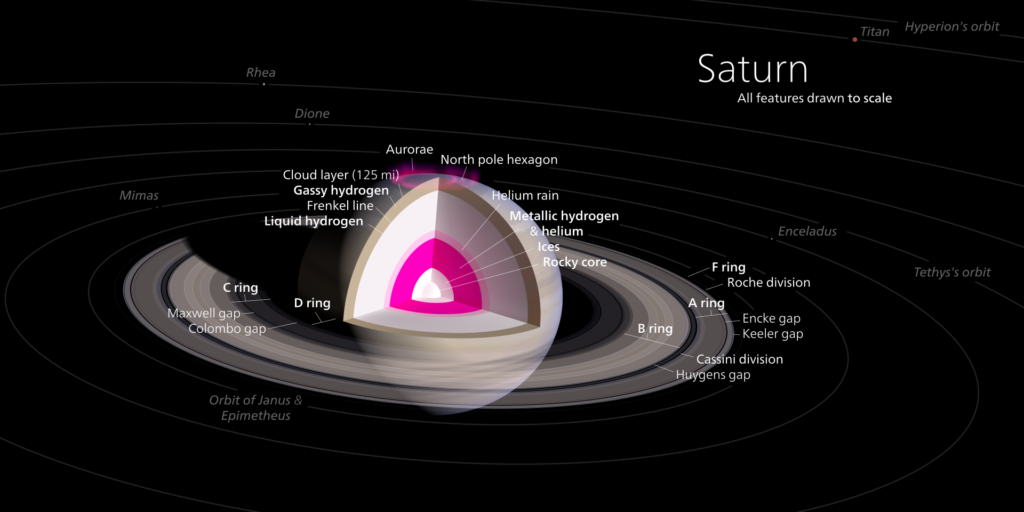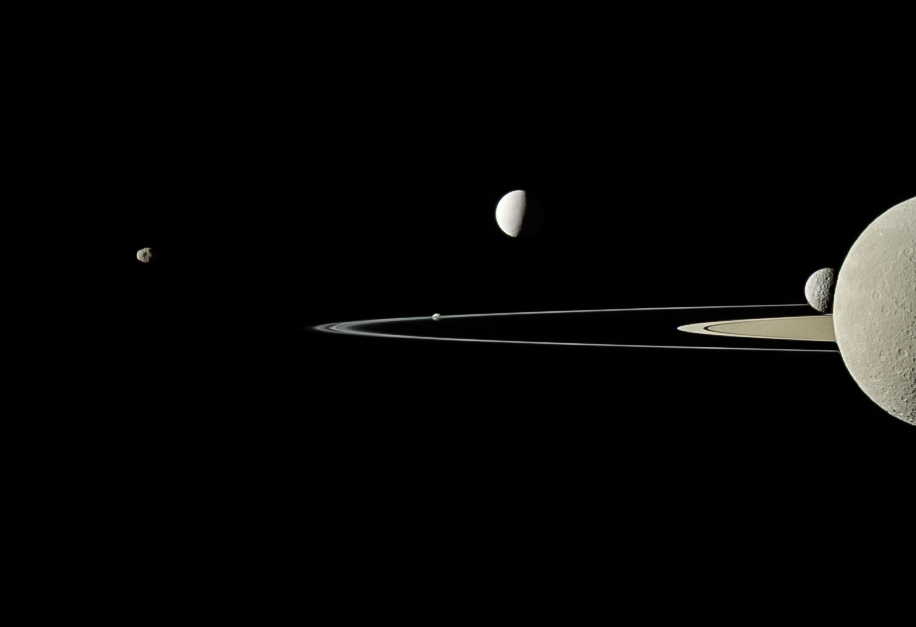Named after the Roman god of wealth and agriculture, Saturn is the 6th planet from the Sun, about 9.5 astronomical units away from the sun (1 AU is the distance of the Earth from the sun) and the second largest after Jupiter with a radius (58,233 km) about nine times that of the Earth.
Saturn is the most distant planet easily visible to the naked eye from Earth. It is possible to view the rings through very strong binoculars or a small telescope.
As a gas giant, it is made from predominantly Hydrogen and Helium. At Saturn’s centre is a core of iron and nickel surrounded by rocky material and other compounds solidified by the intense pressure. Surrounding this core is a layer of liquid metallic hydrogen which is itself surrounded by a layer of Helium saturated liquid hydrogen that eventually becomes a gas towards the surface. The planet has a yellow colour due to ammonia crystals in the upper atmosphere. Saturn is actually the least dense planet in the solar system and would actually float on water if there was an ocean large enough. The outer atmosphere consists of 96.3% Hydrogen and 3.7% Helium with trace amounts of Ammonia, Methane, Ethane, Propane, Acetylene and phosphene.
The rocky core of Saturn is estimated to be a similar composition to Earth with a diameter of around 25,000 km and between 9-22 times the mass of the Earth. Saturn has an internal heat source, radiating 2.5 times more energy into space than it receives from the sun. The core reaches 11,700 decrees C. The thermal energy released by Jupiter is due to slow gravitational compression but this process is thought to be insufficient to explain the energy released by Saturn. It is thought that additional heat may be generated through the raining out of droplets of Helium deep in the interior. As the droplets decend through the Hydrogen, they release heat by friction and leave the outer layers depleted of Helium. These droplets may have formed a Helium shell around the core.

The planet is covered with clouds and storms and is various shades of yellow, brown and grey. The winds in the upper atmosphere reach an incredible 500 m/s which is approximately five times that of the strongest winds recorded on Earth and the second strongest in the solar system behind Neptune. The North Pole has a six sided jet stream of 200 mph winds spanning about 20,000 miles with a massive rotating storm at the centre. This weather feature is unique in the solar system.
Perhaps the most famous thing about Saturn, however, has to be its beautiful rings which are made of predomenantly of ice with a smaller amount of rocks and dust. It is not certain exacty how they formed but they are likely to be remnants of comets, asteroids or shattered moons torn apart by Saturn’s gravity. The individual particles range from the size of dust to the size of a house with some as large as mountains. The ring system extends up to 175,000 miles but they are very thin with the verticle height being only 30 feet.
Saturn has the second shortest day in the solar system with one day only taking 10.7 hours. A Saturn year is about 29.4 Earth years. It’s axis is tilted by almost 27 degrees which means the planet experiences seasons
Saturn has an incredible 53 confirmed moons with 29 additional moons awaiting confirmation. Titan, the largest moon of Saturn and the second largest in the solar system makes up some 90% of the total mass of material orbiting the planet and is the only one in the solar system have a major atmosphere in which complex organic chemistry occurs.

This incredible photo is taken by the Cassini probe. From left to right the five moons pictured here are Janus, Pandora, Enceladus, Mimas, and in the foreground is Rhea.